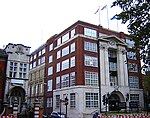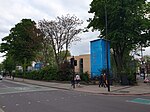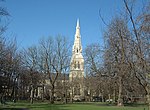South London Gallery
1891 establishments in England1891 in LondonArt museums established in 1891Buildings and structures in the London Borough of SouthwarkCamberwell ... and 3 more
Contemporary art galleries in LondonMuseums in the London Borough of SouthwarkUse British English from August 2015

The South London Gallery, founded 1891, is a public-funded gallery of contemporary art in Camberwell, London. Until 1992, it was known as the South London Art Gallery, and nowadays the acronym SLG is often used. Margot Heller became its director in 2001.
Excerpt from the Wikipedia article South London Gallery (License: CC BY-SA 3.0, Authors, Images).South London Gallery
Peckham Road, London Peckham (London Borough of Southwark)
Geographical coordinates (GPS) Address Nearby Places Show on map
Geographical coordinates (GPS)
| Latitude | Longitude |
|---|---|
| N 51.474166666667 ° | E -0.079722222222222 ° |
Address
C Block
Peckham Road
SE5 8PS London, Peckham (London Borough of Southwark)
England, United Kingdom
Open on Google Maps






